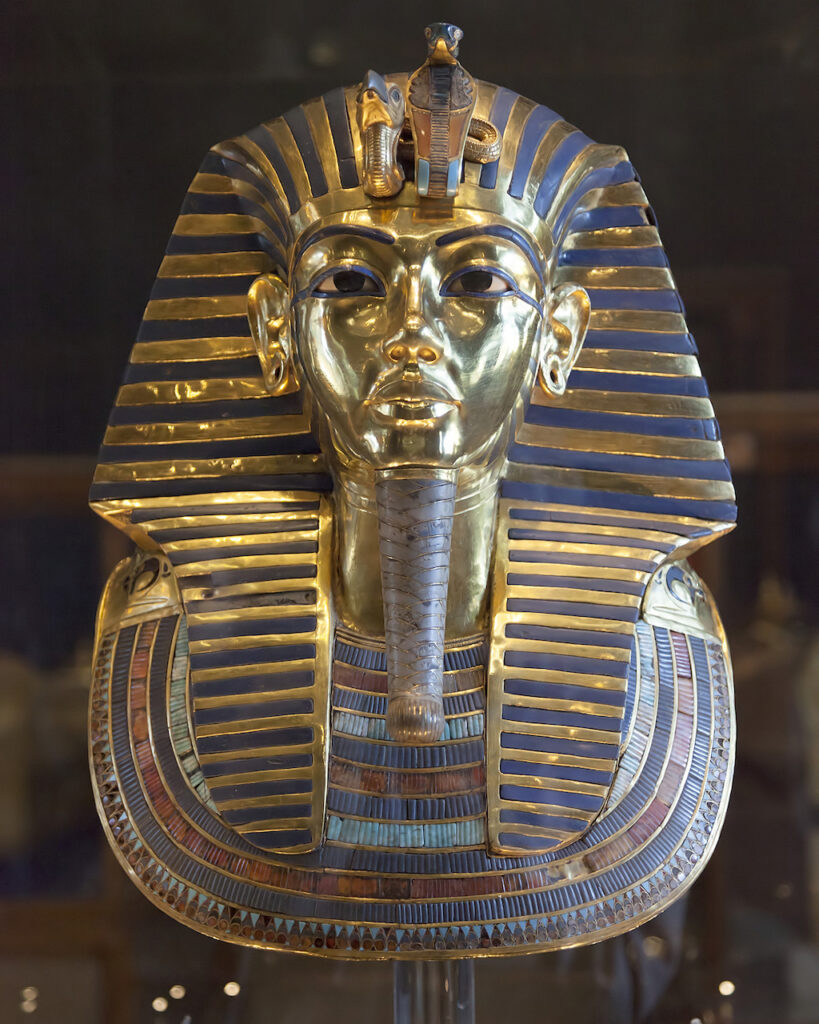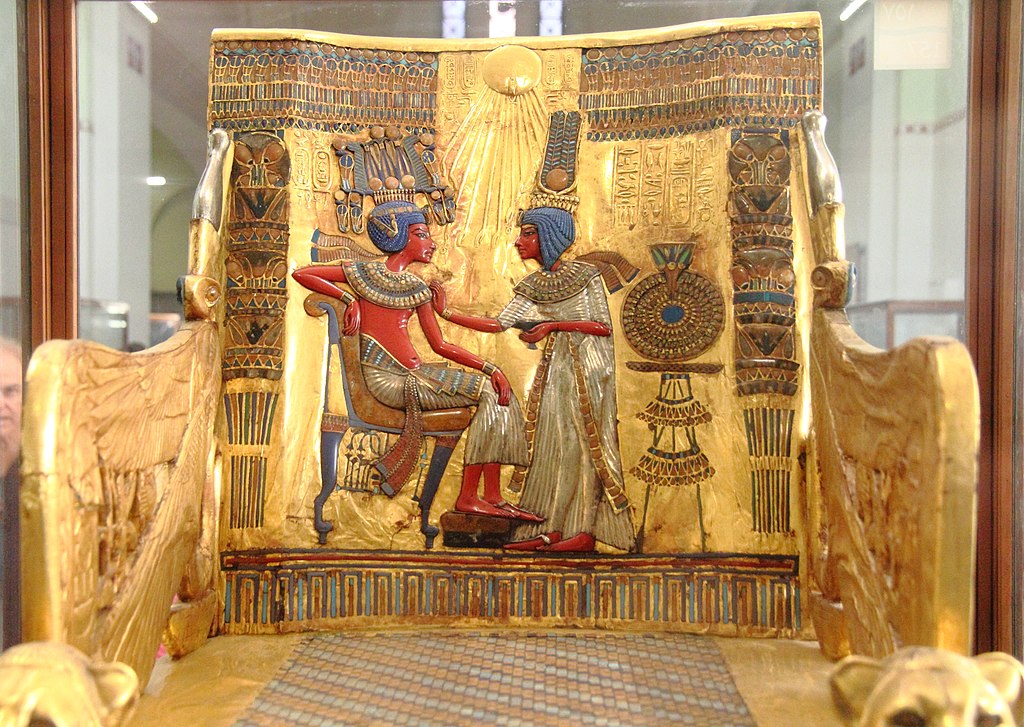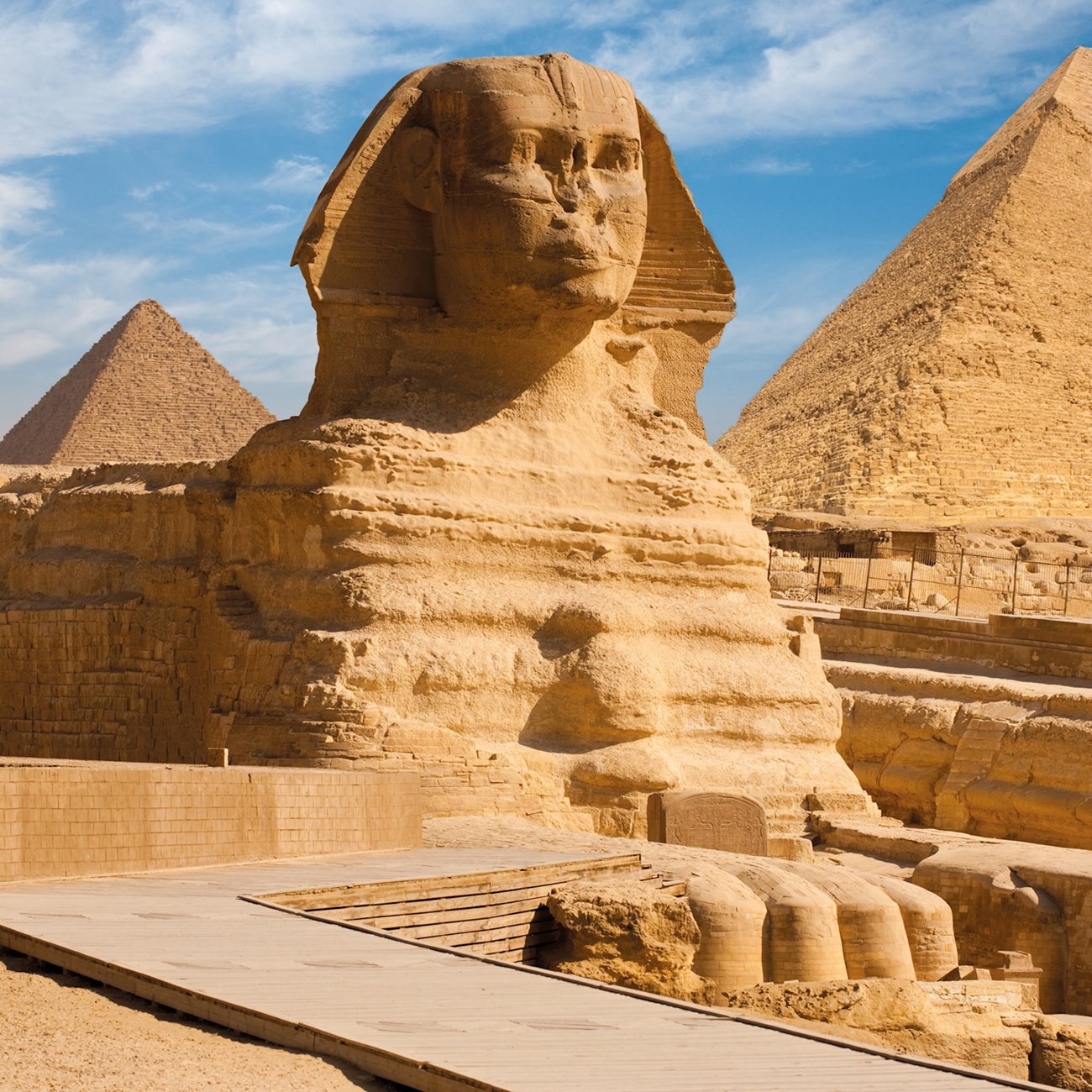How Egyptian Archaeology Continues to Astound the World, with Egyptologist Hani
10 Tutankhamun Treasures You Can Only See at the Grand Egyptian Museum
With its world-famous wonders and pioneering innovations, few countries can claim a heritage as rich and enduring as Egypt’s. Now, the treasures of this ancient civilization have a new home: the Grand Egyptian Museum.
The Grand Egyptian Museum is located just outside Cairo facing the Great Pyramids, and after over two decades in the making this magnificent complex now takes the titles of the largest archaeological museum on Earth. Inside, more than 100,000 artifacts tell the story of Egypt, from the dawn of civilization to the Greco-Roman era. There’s one section that visitors are particularly excited about – King Tutankhamun’s tomb.
Inside the museum, for the first time since his tomb was discovered in 1922 all of Tutankhamun’s treasures will be displayed together, giving visitors an unforgettable journey into the life of the boy king. Where to start? Here are ten of the Grand Egyptian Museum’s highlights of Tutankhamun’s treasures, explained by Insight Vacations Travel Director and Egyptologist, Assem.

Meet Assem, a trained Egyptologist
1. Gold mask of Tutankhamun
This stupendous mask of King Tutankhamun is made of solid gold, and ornamented with lapis lazuli, turquoise, carnelian and coloured-glass paste. It is a masterpiece indeed, and one of the highlights among the Grand Egyptian Museum’s treasures. The 11-kilo mask was found covering the mummy’s head and shoulders, and shows the king as a young man in his teens. He is wearing the royal headdress with a cobra and a vulture over the forehead, symbols of the unification of Upper and Lower Egypt.
The eyebrows and eye lines are inlaid with lapis lazuli, and the eyes themselves are inlaid with obsidian and white quartz. The red dot at the corner of each eye adds a touch of realism to the mask. The king is wearing a false funerary beard with a curved end, which is again inlaid with lapis lazuli. The chest is covered with a large multi-tiered pectoral, also inlaid with lapis lazuli as well as turquoise and carnelian, and culminating at the sides with falcon heads.

Tutankhamun’s gold death mask. Image credit: Roland Unger via Wikimedia Commons
The protection of the head of the deceased was one of the important concerns in ancient Egypt; the mask provided a permanent substitute for the head in case of damage.
An x-ray was taken of Tutankhamun’s golden mask The Golden Mask of King Tutankhamun. Until recently archaeologists believed that the mask was made from one piece, but it revealed that the mask contains more than one, welded so precisely that is not visible to the naked eye. Everyone was astonished by what the ancient Egyptian civilization had reached in terms of knowledge and progress in the field of alloys and the gold industry.
2. Inner gold coffin of Tutankhamun
This anthropoid coffin was the innermost of three coffins, which were placed one inside the other, and then placed in turn within a larger rectangular quartzite sarcophagus with a granite lid. The inner coffin is made of solid gold and weighs 110 kg, while the other two coffins are made of gilded wood.
When discovered, the coffins rested inside each other so tightly that it was impossible to insert even your little finger between them. The funeral libation poured over the coffins during the funerary rites, such as wine, had stiffened and solidified like cement. Freeing them caused damage to much of the decorative and inlay work, although this was later restored.

Construction of the GEM was first announced in 1992, while actual work began in 2005, and it officially opened in November 2025.
3. Golden Throne of Tutankhamun
One of the masterpieces, this throne is made of wood that was covered with gold leaf, and then inlaid with silver and semi-precious stones, such as turquoise, lapis lazuli, and carnelian. The throne was found underneath the funerary couches, in the antechamber of the tomb.
The legs of the throne are typically in the form of lion’s paws, resting on cylindrical objects. The two lions’ heads sit on top of the frontal legs to flank the seated on the throne, guarding him.
The arms are in the form of two cobras with the wings of the vulture, again combining the two protective goddesses of Upper and Lower Egypt. The cobra wears the Double Crown, a symbolic headdress that combined the white crown of Upper Egypt and the red crown of Lower Egypt; the white is made of silver and the red is made of gold.

The gilded throne of Tutankhamun. Image credit: Djehouty via Wikimedia Commons
4. Canopic shrine
Found in the treasure room of Tutankhamun’s tomb, this gilded golden wooden shrine stood against the east wall, facing the door of the chamber. It contained a smaller alabaster canopic chest that in turn housed the four canopic jars (funerary vessels used during mummification preserve the deceased’s internal organs for the afterlife). Inside these jars were the four miniature coffins with the internal organs of the king.
The shrine is surrounded by a canopy formed of four pillars that support the roof, which features a cavetto cornice. The upper part of the roof is decorated with protective cobras inlaid with coloured-glass paste, with solar discs on each snake’s head.
Four goddesses surround the shrine – one on each wall, spreading their arms in a protective manner. The head of one is turned, showing alertness and a readiness to attack any intruder, as an added measure for the safety and protection of the chest.
5. Shabti of Tutankhamun
Shabti figures were a common feature of most large Egyptian burials, first appearing in tombs of the late Middle Kingdom as substitutes for the deceased. By the 18th Dynasty, the shabti had become the dead man’s deputy, charged with working on his behalf in the next world on any menial agricultural tasks. This role was reflected in the implements such as a pick, a hoe, and baskets which, were commonly provided from the mid 18th Dynasty.
A large number of the funerary figurines were placed inside the tomb. From the New Kingdom onwards the number reached a total of 401, including 365 workmen (one for each day of the year) carrying hoes and baskets ready for the work assigned to them, plus 36 overseers to direct the work. The tomb of Tutankhamun contained 413 shawabtis: 365 workmen, 36 overseers and 12 supplementary foremen, one for each month.

Image credit: Grand Egyptian Museum
6. Ceremonial Chariot
Four chariots were found dismantled in the antechamber of the tomb, likely dismantled to allow them to pass through the tomb’s narrow entrance. They remained inside the tomb in pieces, and were nearly lost after tomb robbers had broken into the tomb, rifled through the objects, and left in a heap.
However, once reassembled the chariots proved to be in an excellent state of preservation. They are all made of wood covered with a gold leaf; details on the outside body of the chariot are in glass or semi-precious stones. One chariot is likely to have been of a ceremonial use – Tutankhamun was not one of the warrior kings, as all scenes showing him on a chariot were either hunting, parades or riding.
7. Ceremonial Chair
The chair in ancient Egypt was a symbol of authority and prestige. It was of no surprise to the excavators to find a selection of chairs and stools buried with Tutankhamun, as with Thutmosis IV (the 8th Pharaoh of the 18th Dynasty of Egypt) and others before him.
This chair comes from the annex of Tutankhamun’s tomb. It is carved of wood inlaid with ebony, ivory and semi-precious stones, and also partly gilded. Howard Carter, the British archaeologist and Egyptologist who discovered the Tutankhamun’s tomb in November 1922, compared it with the fold-stool used by the bishops in cathedrals, and it has often been called the ‘ecclesiastical throne’.
Save up to $3,000* per couple on your first Premium Tour
Plus receive latest offers, travel inspiration, and discover how your travels will make a positive impact. Together, WE MAKE TRAVEL MATTER®. Subscribe Now8. Folding Bed
Unlike the large, ritualistic couches which filled one wall of the tomb’s antechamber, the smaller beds and bed-parts recovered were intended for use, or at least modeled upon the type of everyday bed found in the richer Egyptian households. All take the same general shape: dipping in the middle, and fitted with a rectangular footboard.
The south end of the annex yielded the only intact, full-sized example of a traveling bed to have survived from ancient Egypt. Made of light wood and measuring 1.79 meters, its length is interrupted at two points by heavy, copper hinged-joints. Four extra legs are hinged to fold inwards when the bed is closed up.
9. Game-board of Tutankhamun
The gameboards, discovered in the annex to the antechamber of the tomb, are carved of wood and inlaid with ivory. The largest one has its legs in the form of lion’s paws, mounted on a sledge. The boards vary in size – there is even a pocket-size one, for the king to take on his trips.
This game is called senet, which means ‘to pass’. The board consists of thirty square divided into three rows of ten. The players would have thrown little sticks or dice. By blocking or removing the opponent’s pieces a player would be closer to winning, so each aimed to remove the pieces of his opponent first.
The game was so favored so it became a part of the funerary equipments for tombs, to indicate that the deceased wanted to also play it in the afterlife.

Ivory inlaid game board. Image credit: لا روسا via Wikimedia Commons
10. Cane with Two Prisoners
The traditional enemies of Egypt were represented in diverse ways: on the temple walls, around the bases of statues, or even stretched out on the stool upon which the king rested his feet. Here, they are shown as the handle of a cane in the hand of the king.
The number of sticks and staves buried with Tutankhamun was around 130, which led Carter to speculate that ‘the young Tutankhamun must have been an amateur collector of walking sticks and staves’. Many of them were clearly ritual, others however showed signs of use.
Discover this country’s ancient past at the Grand Egyptian Museum on our premium Egypt tours.

LIKED THIS POST? SHARE WITH YOUR COMMUNITY





